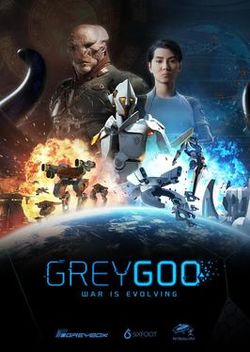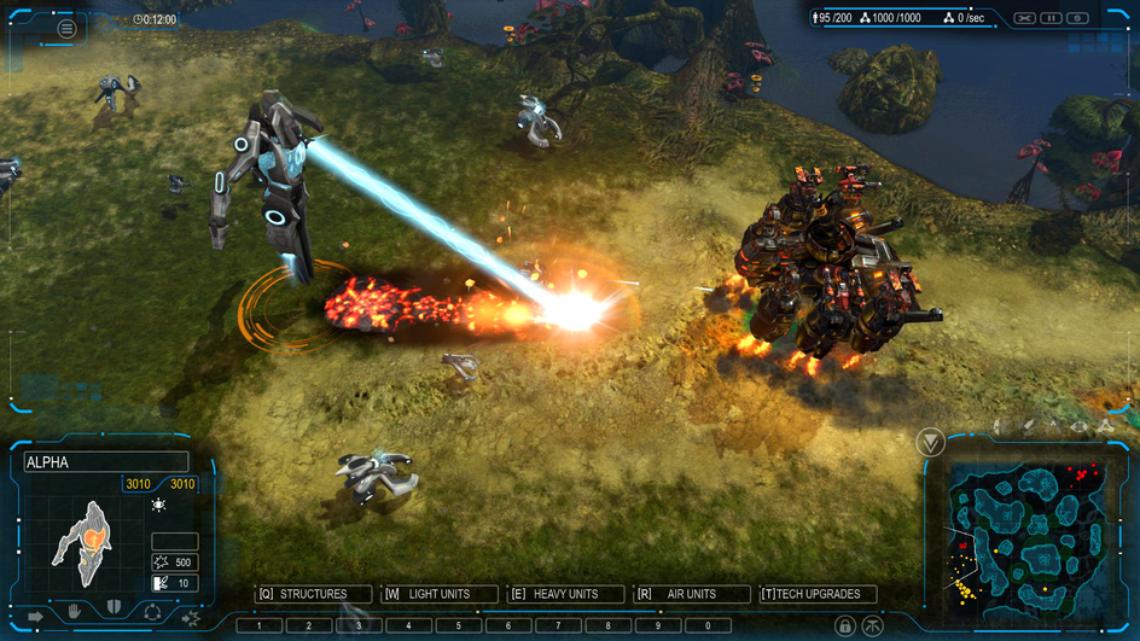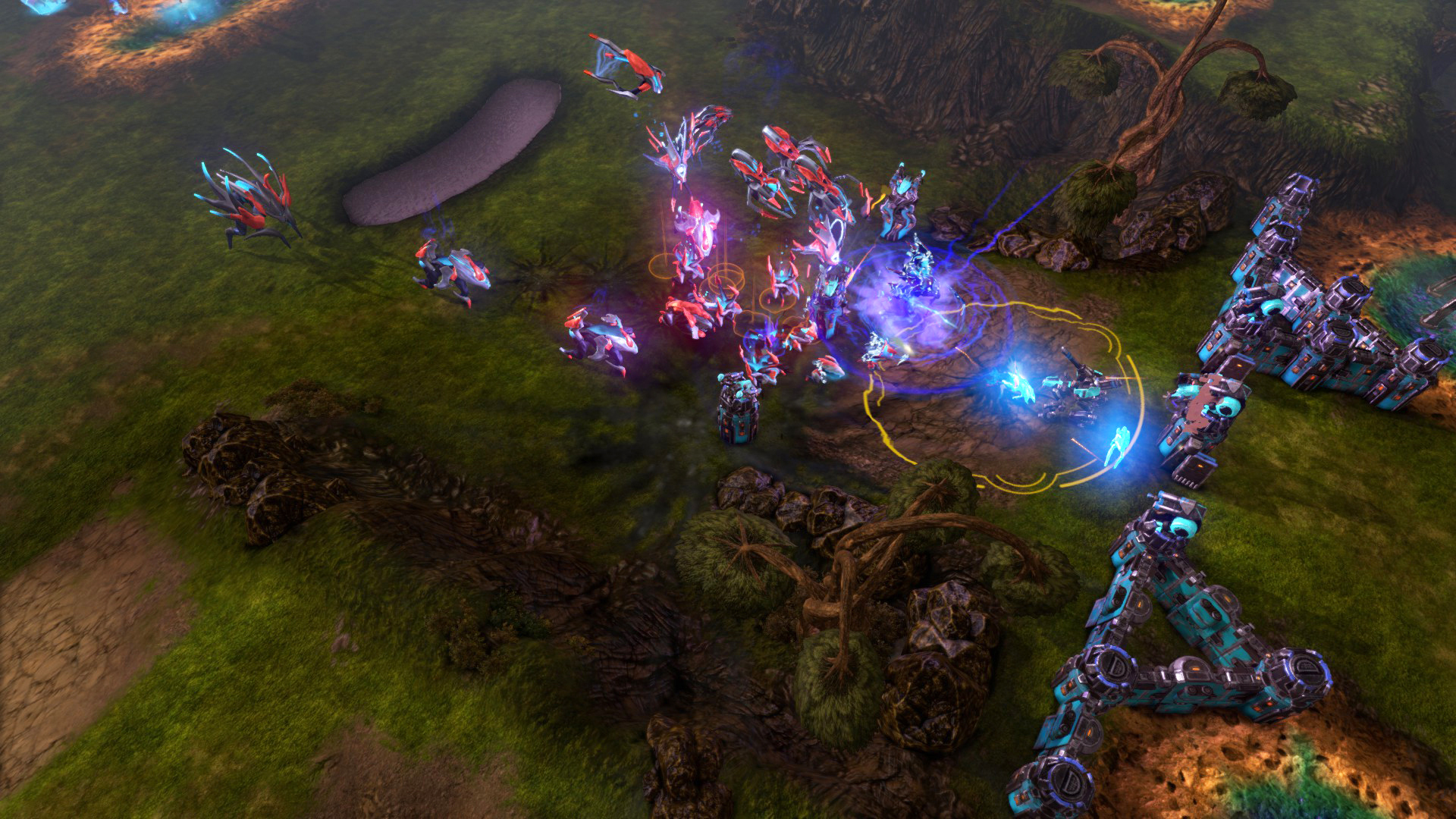Search
[{{{type}}}] {{{reason}}}
{{/data.error.root_cause}}{{{_source.title}}} {{#_source.showPrice}} {{{_source.displayPrice}}} {{/_source.showPrice}}
{{#_source.showLink}} {{/_source.showLink}} {{#_source.showDate}}{{{_source.displayDate}}}
{{/_source.showDate}}{{{_source.description}}}
{{#_source.additionalInfo}}{{#_source.additionalFields}} {{#title}} {{{label}}}: {{{title}}} {{/title}} {{/_source.additionalFields}}
{{/_source.additionalInfo}}Grey Goo (PC)

Grey Goo
Developed By: Petroglyph
Published By: Grey Box
Released: January 23, 2015
Available On: Windows
Genre: Real-time strategy (RTS)
PEGI Rating: 12 (Violence, Online gameplay)
Number of Players: 1-6 offline, 1-6 online
Price: $29.99
(Humble Store Link)
Thank you Grey Box for sending us this game to review!
Grey Goo feels very much like the real-time strategy game series Command and Conquer. Perhaps it's because the development team consists of the same people. And that's a good thing. It’s an RTS made by veterans who have honed their skills over many years to create a worthy RTS title which includes a story spanning over 3 factions through its campaign.
Convinced they are alone, mankind is forced to cleanse a man made exploration tool gone awry, the Goo, which threatens their survival. Starting the campaign, you begin as the Beta on their home planet. The Beta are an alien race attempting to secure their own survival from an ancient enemy.
Catalyst is the primary and single resource for Grey Goo. Build a refinery and resource collectors will start collecting catalyst from the pools dotted around the map. Catalyst is then used in base production and building of units.
For all factions you have logistics, limiting the amount of structures and units you can produce. Each structure and unit has its own logistic cost depending on its strategic value. When you reach your logistic limit production is stopped. I suppose this adds a strategic element for those who really want to delve into the rock paper scissors element of RTS games towards building specific units to counter enemy units effectively with minimum loss to your own.

Strong Points: Solid RTS mechanics; each faction has a unique base building mechanic
Weak Points: Slow paced
Moral Warnings: Violence, humanoid characters can be killed
The way in which each faction builds its bases are unique. The humans use conduit lines that expand out from their headquarters which other structures are built off of. This limits the expansion of the humans as conduit lines can be blocked by terrain or destroyed, cutting off power and disabling structures. On the plus side structures can then be teleported around, so long as they remain attached to a conduit line connected to the headquarters. That means, if you have some turrets that are on the opposite side of the base in relation to an enemy force, you can teleport them to the conduit line closest to the attacking enemy. You can reposition as many times as you want, allowing you to spend your catalyst and logistics on offensive forces instead of defensive structures.
The Beta can build anywhere, provided they have line of sight. Their structures need to be attached to hubs that have capacity for either 2, 4 or 6 structures. Dropships are called to bring down buildings from the air. This allows for rapid expansion, so long as there are enough units to defend the structures from patrols that roam the map in single player.
The Goo mixes up base building entirely. Instead of a static headquarters they have a Mother Goo that sits on top of a catalyst pool, which spawns units and more Mother Goo. Mother Goo are mobile and the Goo in general can traverse the most difficult terrain, making it more difficult to track them down and kill them. Producing more Mother Goo and sitting them on other catalyst pools not only speeds up production but allows the Goo to potentially attack from multiple directions.
All units and structures are grouped under different tabs. This design choice makes it difficult to find what you are looking for until you get used to the interface. In the long term this helps reduce the amount of information displayed on the screen and allows for faster access without having to scroll through a long list or select a specific building to queue up units. A simple technology tree allows the unlocking or enhancement of abilities for a selection of units. There are 3 choices per unit, with only 1 choice that can be applied.

Higher is better
(10/10 is perfect)
Game Score - 96%
Gameplay - 18/20
Graphics - 10/10
Sound - 10/10
Stability - 5/5
Controls - 5/5
Morality Score - 92%
Violence - 6/10
Language - 10/10
Sexual Content - 10/10
Occult/Supernatural - 10/10
Cultural/Moral/Ethical - 10/10
A great deal of effort has gone into creating the CGI cutscenes used to deliver the continuing story sporadically throughout the campaign. Mission briefings are delivered by talking heads that look realistic and move naturally. At first glance it closely resembles CGI mixed in with real actors wearing makeup and prosthetics, and it is entirely created via CGI. A nice touch in the opening cutscene, the Beta talk in their own alien language. The voice acting is great and fits in well with the narrative and characters. You can feel the love and dedication that has gone into the production.
Voice acting, sound effects and music fit very neatly. Command & Conquer veterans will be pleased to know that the music is scored by Frank Klepacki, adding atmosphere and tension to the game. A vast array of options is provided in the audio setting department, more than you would expect, yet pleasing to have. There are various sliders for all the different sound effects and voices for tuning to your heart’s content.
The game suffers from longer than expected loading and save times. If you like to save and reload often after a mistake then long saving and loading times may encourage you not to do so. Saving and reloading often isn't really needed, at least on the normal difficulty I experienced. On average I saved no more than a few times on some missions (if I even remembered to do so). The normal difficulty was more challenging than expected, but rewarding to overcome. On my first play through I needed a few restarts on some of the earlier missions, but once I became more familiar with the interface and game mechanics I was able to improve my skills, so that the rest of the campaign didn’t feel overly challenging. There is a hard and easy difficulty for those who want more of the challenge or prefer to just enjoy the experience and story. The game's pace is slow in comparison to StarCraft and less intensive as it’s not a race of how many actions you can perform per minute.
For players interested in multiplayer, there is skirmish (player Vs. AI) and multiplayer (player Vs. player). In skirmish, the AI has an increased range of difficulties and behaviour presets to choose from (i.e. offensive, defensive, idle, etc). Multiplayer offers online with ranked and unranked matches, with 1v1, 2v2 or Free For All ranked matches or choose to customise your own unranked match. There is also a replay feature and LAN (Local Area Network) support is also included.
The game requires the destruction of enemy forces, with some variations which require you to survive a certain amount of time. Violence involves the destruction of mostly mechanized units. There are some humanoid alien units who will fall over on death and then vanish.
Overall, Grey Goo is a fun game to play and has been crafted by the veteran developers who know what their core audience is looking for in an RTS. They have crafted an interesting and unique story driven campaign uncovered by progressing through each of the 3 factions. The different building mechanics and unit selection offer up a unique gameplay experience for each faction, adding to the game's longevity for those who wish to master each race in skirmish or multiplayer. If you have overlooked this gem of an RTS on initial release, then now would be a good time to pick it up.
Dan Woods (@themudpig)




